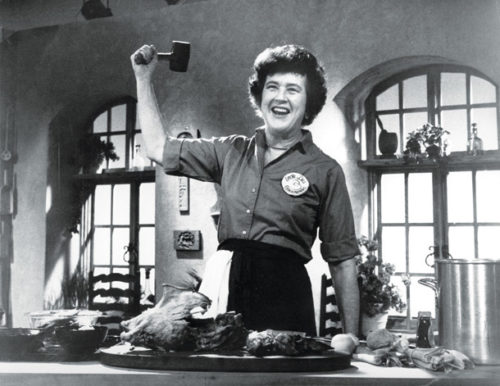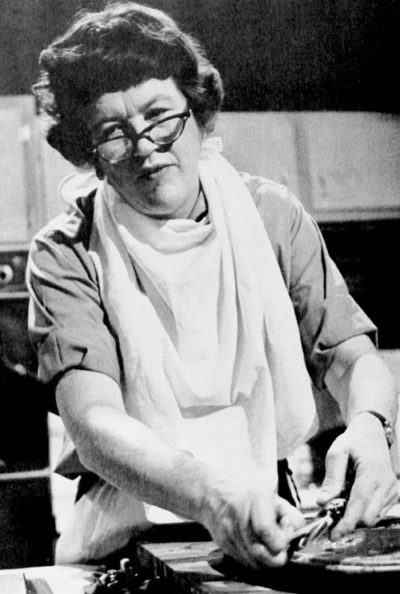
Originally published August 8, 1964
In New York’s Greenwich Village, a coterie of avant-garde painters and musicians gathers each week in a loft to watch The French Chef, convinced that Mrs. Child is far more diverting than any professional comedian. At first they assumed that she was doing a parody of the traditional cooking program, but even the discovery that she was playing it straight failed to dull their enthusiasm.
In the garrets around Washington Square, the introduction to the lesson on artichokes stands as the authoritative example of Mrs. Child’s humor and style. The scene opened on an artichoke boiling in a pot of water and shrouded by a piece of cheesecloth. Mrs. Child, looming suddenly into view, lifted the cheesecloth with heavy tweezers and inquired, “What’s cooking under this gossamer veil? Why here’s a great big, bad artichoke, and some people are afraid of it.”
Of the other two remarks still quoted in the coffeehouses, the first concerned a chicken in a frying pan. “We just leave it there,” said Mrs. Child, “letting it make simple little cooking noises.” The second had to do with crêpes suzette. As she put a match to it, she said, “You must be careful not to set your hair on fire.”
In the less-threatening circumstances of her own home in Cambridge, Mrs. Child reveals herself as an even more engaging woman than she seems on television. She stands over 6 feet tall (her dress size she describes as “stately”), her eyes are grayish green, her hair brown, and her complexion freckled.

Mrs. Child’s premise is that French cooking is “neither so long, so rich, nor so complicated” that it cannot be accomplished by anybody willing to take the necessary trouble. “It doesn’t have to be fancy,” she says, “but you have to care about what you buy; squeeze the tomatoes, shun the bottled salad dressing — that sort of thing.
“Most of the food in this country is frightful,” she said. “It’s because people don’t care enough, just a matter of bad habits.”
Each of her cooking lessons has about it the uncertainty of a reckless adventure. She has a way of losing things — either the butter, or the carrots she so carefully chopped into small cubes, or, on one memorable occasion, a pot of cauliflower. Sometimes she forgets to put the seasoning in the ragout; sometimes she drops a turkey in the sink.
But to Mrs. Child, these slight misfortunes are of no importance, merely the expected hazards of a long and dirty war. Smiling and undismayed, secure in the knowledge that her cause is just, she bashes on, perhaps pausing to remark, as she did once of a potato pancake spilled on a sideboard, “If this happens, just scoop it back into the pan; remember that you are alone in the kitchen and nobody can see you.”
When, at the end of the program, she at last brings the finished dish to the table, she does so with an air of delighted surprise, pleased to announce that once again the forces of art and reason have triumphed over primeval chaos.
—“Everybody’s in the Kitchen with Julia” by Lewis Lapham, August 8, 1964
This article is featured in the July/August 2018 issue of The Saturday Evening Post. Subscribe to the magazine for more art, inspiring stories, fiction, humor, and features from our archives.
Become a Saturday Evening Post member and enjoy unlimited access. Subscribe now



